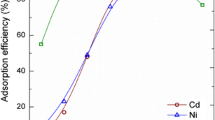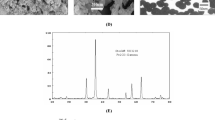Abstract
In aquatic environment, the existence of antibiotics including sulfadiazine (SDZ) has gain a huge attention. It is suggested that hydrous metal oxides have large potential to remove contaminants in water. The SDZ removal capability by ferric and manganese binary oxides (FMBO) was investigated, and the SDZ removal performance was compared with the ferric hydroxide (HFO) and manganese dioxide (HMO). Our results showed that SDZ removal was highly pH-dependent, but pH has less effect on uptake of SDZ on FMBO than that of the other two adsorbents. The surface acidity constant of FMBO was first calculated to be 6.31 and 8.48, respectively. The uptake process was successfully fitted for according to surface complex formation models (SCFM) and the results of modern surface analytical methods, such as FTIR and XPS, were also consistent with the surface complex uptake mechanism. The uptake of SDZ by FMBO ascribed to specific chemical interaction between the aniline group of SDZ and the hydroxyl groups from FMBO.










Similar content being viewed by others
References
Ahmed MB, Zhou JL, Ngo HH, Guo W, Johir MAH, Belhaj D (2017) Competitive sorption affinity of sulfonamides and chloramphenicol antibiotics toward functionalized biochar for water and wastewater treatment. Bioresour Technol 238:306–312
Akhtar J, Amin NS, Aris A (2011) Combined adsorption and catalytic ozonation for removal of sulfamethoxazole using Fe2O3/CeO2 loaded activated carbon. Chem Eng J 170(1):136–144
Babić S, Zrnčić M, Ljubas D, Ćurković L, Škorić I (2015) Photolytic and thin TiO2 film assisted photocatalytic degradation of sulfamethazine in aqueous solution. Environ Sci Pollut Res 22(15):11372–11386
Batt AL, Snow DD, Aga DS (2006) Occurrence of sulfonamide antimicrobials in private water wells in Washington County, Idaho, USA. Chemosphere 64(11):1963–1971
Ben WW, Qiang ZM, Adams C, Zhang HQ, Chen LP (2008) Simultaneous determination of sulfonamides, tetracyclines and tiamulin in swine wastewater by solid-phase extraction and liquid chromatography-mass spectrometry. J Chromatogr A 1202(2):173–180
Billon G, Ouddane B, Gengembre L, Boughriet A (2002) On the chemical properties of sedimentary sulfur in estuarine environments. Phys Chem Chem Phys 4:751–756
Braschi I, Blasioli S, Gigli L, Gessa CE, Alberti A, Martucci A (2010) Removal of sulfonamide antibiotics from water: evidence of adsorption into an organophilic zeolite Y by its structural modifications. J Hazard Mater 178(1–3):218–225
Choi KJ, Kim SG, Kim SH (2008) Removal of tetracycline and sulfonamide classes of antibiotic compound by powdered activated carbon. Environ Technol 29(3):333–342
Dambies L, Guimon C, Yiacoumi S, Guibal E (2001) Characterization of metal ion interactions with chitosan by X-ray photoelectron spectroscopy. Colloids Surf A Physicochem Eng Asp 177(2–3):203–214
Deng SB, Liu H, Zhou W, Huang J, Yu G (2011) Mn-Ce oxide as a high-capacity adsorbent for fluoride removal from water. J Hazard Mater 186:1360–1366
Doretto KM, Rath S (2013) Sorption of sulfadiazine on Brazilian soils. Chemosphere 90(6):2027–2034
Faria MCS, Rosemberg RS, Bomfeti CA, Monteiro DS, Barbosa F, Oliveira LCA, Rodriguez M, Pereira MC, Rodrigues JL (2014) Arsenic removal from contaminated water by ultrafine delta-FeOOH adsorbents. Chem Eng J 237(1):47–54
Feitosa-Felizzola J, Hanna K, Chiron S (2009) Adsorption and transformation of selected human-used macrolide antibacterial agents with iron(III) and manganese(IV) oxides. Environ Pollut 157(4):1317–1322
Figueroa RA, Mackay AA (2005) Sorption of oxytetracycline to iron oxides and iron oxide-rich soils. Environ Sci Technol 39(17):6664–6671
Gao Y, Li Y, Zhang L, Huang H, Hu J, Shah SM, Su X (2012) Adsorption and removal of tetracycline antibiotics from aqueous solution by graphene oxide. J Colloid Interface Sci 368(1):540–546
García-Galán MJ, Garrido T, Fraile J, Ginebreda A, Díaz-Cruz MS, Barceló D (2010) Simultaneous occurrence of nitrates and sulfonamide antibiotics in two ground water bodies of Catalonia (Spain). J Hydrol 383(1–2):93–101
Grandclément C, Seyssiecq I, Piram A, Wong-Wah-Chung P, Vanot G, Tiliacos N, Roche N, Doumenq P (2017) From the conventional biological wastewater treatment to hybrid processes, the evaluation of organic micropollutant removal: a review. Water Res 111:297–317
Gu C, Karthikeyan KG (2005) Interaction of tetracycline with aluminum and iron hydrous oxides. Environ Sci Technol 39(8):2660–2667
Guo WQ, Yin R, Zhou XJ, Du JS, Cao HO, Yang SS, Ren NQ (2015) Sulfamethoxazole degradation by ultrasound/ozone oxidation process in water: kinetics, mechanisms, and pathways. Ultrason Sonochem 22:182–187
Harnisch F, Gimkiewicz C, Bogunovic B, Kreuzig R, Schröder U (2013) On the removal of sulfonamides using microbial bioelectrochemical systems. Electrochem Commun 26:77–80
Holm JV, Rugge K, Bjerg PL, Christensen TH (1995) Occurrence and distribution of pharmaceutical organic-compounds in the groundwater down gradient of a landfill (Grindsted, Denmark). Environ Sci Technol 29:1415–1420
Huang CP, Stumm W (1973) Adsorption of cations on hydrous Al2O3. J Colloid Interface Sci 43(2):409–414
Jia A, Hu J, Wu X, Peng H, Wu S, Dong Z (2011) Occurrence and source apportionment of sulfonamides and their metabolites in Liaodong Bay and the adjacent Liao River Basin, North China. Environ Toxicol Chem 30(6):1252–1260
Jiang LY, Xiao SD, Chen JM (2015) Removal behavior and mechanism of co(II) on the surface of Fe-Mn binary oxide adsorbent. Colloids Surf A Physicochem Eng Asp 479:1–10
Kim SH, Shon HK, Ngo HH (2010) Adsorption characteristics of antibiotics trimethoprim on powdered and granular activated carbon. J Ind Eng Chem 16(3):344–349
Li X, He K, Pan BC, Zhang SJ, Lu L, Zhang WM (2012) Efficient As(III) removal by macroporous anion exchanger-supported Fe-Mn binary oxide: behavior and mechanism. Chem Eng J 193-194:131–138
Liu HJ, Yang Y, Kang J, Fan MH, Qu JH (2012) Removal of tetracycline from water by Fe-Mn binary oxide. J Environ Sci 24(2):242–247
Liu FF, Zhao J, Wang S, Xing B (2016) Adsorption of sulfonamides on reduced graphene oxides as affected by pH and dissolved organic matter. Environ Pollut 210:85–93
Lu JB, Liu HJ, Zhao X, Jefferson W, Cheng F, Qu QH (2014) Phosphate removal from water using freshly formed Fe-Mn binaryoxide: adsorption behaviors and mechanisms. Colloids Surf A Physicochem Eng Asp 455:11–18
Martucci A, Cremonini MA, Blasioli S, Gigli L, Gatti G, Marchese L, Braschi I (2013) Adsorption and reaction of sulfachloropyridazine sulfonamide antibiotic on a high silica mordenite: a structural and spectroscopic combined study. Microporous Mesoporous Mater 170:274–286
Marzorati S, Ragg EM, Longhi M, Formaro L (2015) Low-temperature intermediates to oxygen reduction reaction catalysts based on amine-modified metal-loaded carbons, an XPS and ss-NMR investigation. Mater Chem Phys 162:234–243
Mavrodinova V, Popova M, Yoncheva K, Mihály J, Szegedi Á (2015) Solid-state encapsulation of ag and sulfadiazine on zeolite Y carrier. J Colloid Interface Sci 458:32–38
Mor F, Kocasari FS, Ozdemir G, Oz B (2012) Determination of sulphonamide residues in cattle meats by the charm-II system and validation with high performance liquid chromatography with fluorescence detection. Food Chem 134(3):1645–1649
Mulla SI, Hu A, Sun Q, Li J, Suanon F, Ashfaq M, Yu CP (2017) Biodegradation of sulfamethoxazole in bacteria from three different origins. J Environ Manag 206:93–102
Nielsen L, Biggs MJ, Skinner W, Bandosz TJ (2014) The effects of activated carbon surface features on the reactive adsorption of carbamazepine and sulfamethoxazole. Carbon 80:419–432
Niu HY, Zhang D, Zhang SG, Zhang XL, Meng ZF, Cai YQ (2011) Humic acid coated Fe3O4 magnetic nanoparticles as highly efficient fenton-likecatalyst for complete mineralization of sulfathiazole. J Hazard Mater 190(1–3):559–565
Qiang ZM, Bao XL, Ben WW (2013) MCM-48 modified magnetic mesoporous nanocomposite as an attractive adsorbent for the removal of sulfamethazine from water. Water Res 47(12):4107–4114
Sarmah AK, Meyer MT, Boxall ABA (2006) A global perspective on the use, sales, exposure pathways, occurrence, fate and effects of veterinary antibiotics (Vas) in the environment. Chemosphere 65(5):725–759
Shi LL, Ma FY, Han YL, Zhang XY, Yu HB (2014) Removal of sulfonamide antibiotics by oriented immobilized laccase on Fe3O4 nanoparticles with natural mediators. J Hazard Mater 279:203–211
Sun P, Li Y, Meng T, Zhang R, Song M, Ren J (2018) Removal of sulfonamide antibiotics and human metabolite by biochar and biochar/H2O2 in synthetic urine. Water Res 147:91–100
Tabaciarova J, Micusik M, Fedorko P, Omastova M (2015) Study of polypyrrole aging by XPS, FTIR and conductivity measurements. Polym Degrad Stab 120:392–401
Thiele-Bruhn S (2003) Pharmaceutical antibiotics compounds in soil-a review. Plant Nutr Soil Sci 166(2):145–167
Ungurean A, Oltean M, David L, Leopold N, Prates Ramalho JP, Chiş V (2014) Adsorption of sulfamethoxazole molecule on silver colloids: a joint SERS and DFT study. J Mol Struct 1073:71–76
Wang HW, Zhang DY, Mou SY, Song WJ, Al-Misned FA, Mortuza MG, Pan XL (2015) Simultaneous removal of tetracycline hydrochloride and As(III) using poorly-crystalline manganese dioxide. Chemosphere 136:102–110
Weng CH (2004) Modeling Pb(II) adsorption onto sandy loam soil. J Colloid Interface Sci 272(2):262–270
Xia YX, Meng LY, Jiang YJ, Zhang YS, Dai XX, Zhao MJ (2015) Facile preparation of MnO2 functionalized baker’s yeast composites and their adsorption mechanism for cadmium. Chem Eng J 259(1):927–935
Xiao SJ, Textor M, Spencer ND, Wieland M, Keller B, Sigrist H, Mater J (1997) Immobilization of the cell-adhesive peptide Arg-Gly-Asp-Cys (RGDC) on titanium surfaces by covalent chemical attachment. Sci Mater Med 8(12):867–872
Xie MG, Chen W, Xu ZY (2014) Adsorption of sulfonamides to demineralized pine wood biochars prepared under different thermochemical conditions. Environ Pollut 186:187–194
Xu J, He Y, Zhang Y, Guo CS, Li L, Wang YQ (2013) Removal of sulfadiazine from aqueous solution on kaolinite. Front Environ Sci Eng 7(6):836–843
Xu W, Wang HJ, Liu RP, Zhao X, Qu JH (2015) The mechanism of antimony(III) removal and its reactions on the surfaces of Fe-Mn binary oxide. J Colloid Interface Sci 363(1):320–326
Yan Q, Gao X, Chen YP, Peng XY, Zhang YX, Gan XM, Zi CF, Guo JS (2014) Occurrence, fate and ecotoxicological assessment of pharmaceutically active compounds in wastewater and sludge from wastewater treatment plants in Chongqing, the Three Gorges Reservoir Area. Sci Total Environ 470-471:618–630
Yang WB, Zheng FF, Xue XX, Lu YP (2011) Investigation into adsorption mechanisms of sulfonamides onto porous adsorbents. J Colloid Interface Sci 362(2):503–509
Yang Y, Lu X, Jiang J, Ma J, Liu G, Cao Y, Liu W, Li J, Pang S, Kong X (2017) Degradation of sulfamethoxazole by UV, UV/H2O2 and UV/persulfate (PDS): formation of oxidation products and effect of bicarbonate. Water Res 118:196–207
Zhang G, Qu J, Liu H, Liu R, Wu R (2007) Preparation and evaluation of a novel Fe-Mn binary oxide adsorbent for effective arsenite removal. Water Res 41(9):1921–1928
Zhang G, Liu H, Qu J, Jefferson W (2012) Arsenate uptake and arsenite simultaneous sorption and oxidation by Fe-Mn binary oxides: influence of Mn/Fe ratio, pH, Ca2+, and humic acid. J Colloid Interface Sci 366(1):141–146
Zhang B, Sun BH, Li XX, Yu Y, Tian YQ, Xu XM, Jin ZY (2015) Synthesis of pH- and ionic strength-responsive microgels and their interactions with lysozyme. Int J Biol Macromol 79:392–397
Funding
This work was supported by the Major Science and Technology Program for Water Pollution Control and Treatment of China (2015ZX07204-002) and the National Natural Science Research Fund (No. 51278051).
Author information
Authors and Affiliations
Corresponding author
Additional information
Responsible editor: Tito Roberto Cadaval Jr
Publisher’s note
Springer Nature remains neutral with regard to jurisdictional claims in published maps and institutional affiliations.
Electronic supplementary material
ESM 1
(DOCX 270 kb)
Rights and permissions
About this article
Cite this article
Yu, J., Wang, H. & Ji, Q. Investigating adsorption mechanism and surface complex formation modeling for aqueous sulfadiazine bonding on Fe/Mn binary oxides. Environ Sci Pollut Res 26, 23162–23172 (2019). https://doi.org/10.1007/s11356-019-05611-2
Received:
Accepted:
Published:
Issue Date:
DOI: https://doi.org/10.1007/s11356-019-05611-2




